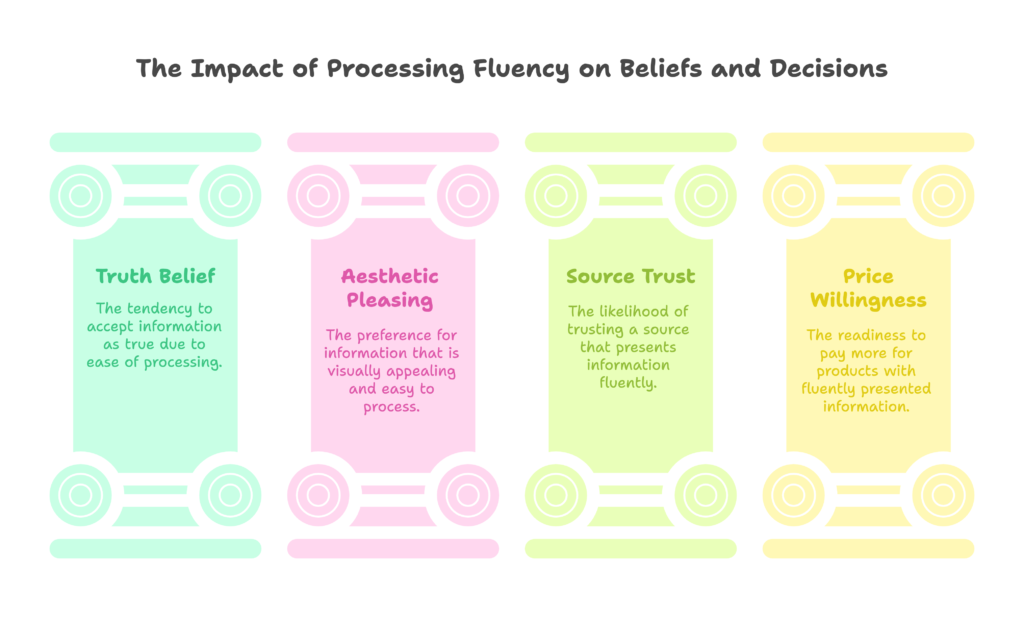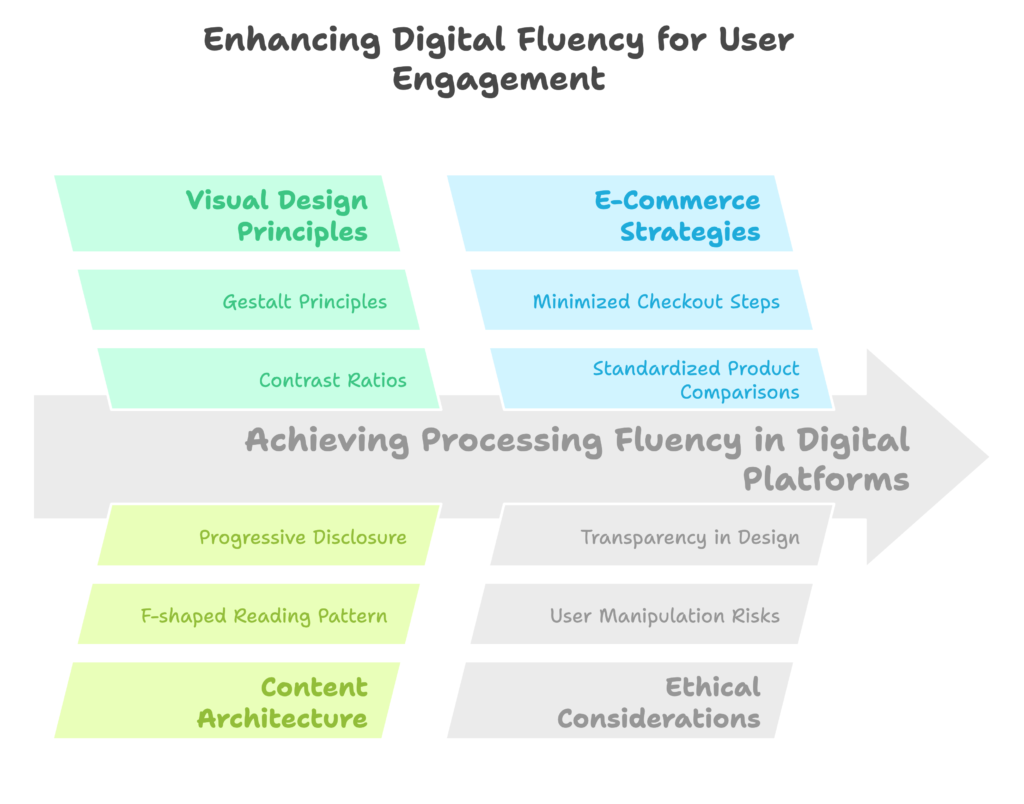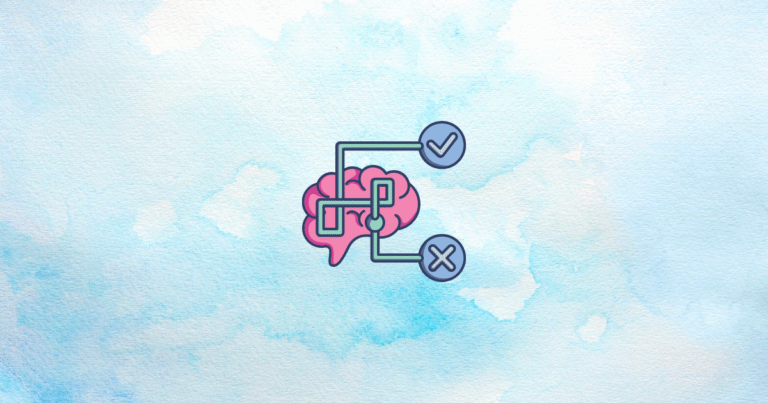Have you ever wondered why some websites feel effortless to navigate while others make your brain hurt? Or why certain advertisements stick in your mind while others are instantly forgotten? The secret might be simpler than you think: processing fluency.
When information flows smoothly into your brain without resistance, magic happens. You understand faster, trust more, and even like the content better. It’s not just about making things pretty—it’s about making them easy for your brain to process.
In this article, you’ll discover:
- What processing fluency is and why your brain craves it
- How businesses use fluency to influence your decisions
- Practical ways to make your own content more digestible
- Real-world examples where fluency boosted results dramatically
Ready to learn the science behind what makes information satisfying to consume? Let’s dive in!
The Science Behind Processing Fluency
At its core, processing fluency is about how easily your brain can take in and understand information. When you encounter something that’s simple to process, your brain experiences less cognitive strain—and that feeling influences how you respond to the information.
Processing fluency comes in three main varieties:
- Perceptual fluency: How easily you can see or perceive something (think clear fonts and high contrast)
- Linguistic fluency: How easily you can understand the language and structure (simple words and straightforward sentences)
- Conceptual fluency: How easily the information fits with what you already know (familiar concepts and expected patterns)
Your brain is actually wired to prefer fluent experiences. When the perirhinal cortex—a part of your brain involved in recognizing familiar things—encounters easy-to-process information, it triggers a subtle but real pleasure response. That’s right: your brain enjoys things that are easy to understand.
From an evolutionary perspective, this makes perfect sense. Our ancestors needed to conserve mental energy and quickly detect potential threats. Information that processed smoothly was likely safe and familiar, while difficult-to-process information signaled something potentially dangerous or unknown that required more attention.
Now that we understand the foundation of processing fluency, let’s see how it affects our everyday decisions. Have you ever wondered why some products seem more trustworthy than others at first glance? The answer might surprise you…
How Processing Fluency Shapes Our Decisions
Processing fluency doesn’t just make information easier to understand—it actually influences how we feel about that information. This effect is so powerful it can shape our judgments, preferences, and buying decisions without us even realizing it.

Here’s what happens in your brain when you encounter fluent information:
- You’re more likely to believe it’s true (the “illusion of truth” effect)
- You tend to find it more aesthetically pleasing
- You’re more likely to trust the source
- You’re willing to pay more for products described fluently
In e-commerce, smart businesses leverage these effects through careful design choices. They optimize fonts and contrast to increase readability. They simplify navigation to reduce cognitive load. They even present prices in ways that make them feel more reasonable.
Healthcare communication benefits tremendously from fluency principles too. When medical instructions are easy to read and understand, patient compliance improves dramatically. One study found that redesigning medication instructions with fluency principles improved adherence by nearly 40%—a life-saving difference!
The power of fluency extends beyond just making things pretty. It fundamentally changes how people interact with and respond to information. But how exactly does your brain process this information? Let’s take a peek inside your head…
What’s Happening in Your Brain
When you encounter information that’s easy to process, your brain responds in fascinating ways. Advanced imaging techniques have allowed scientists to observe these neural mechanisms in action.
During fluent processing, several key things happen in your brain:
- Your prefrontal cortex (responsible for complex thinking) shows reduced activity
- The amygdala (your emotional alarm system) quiets down
- Your basal ganglia engage, enabling more automatic responses
In other words, when information flows smoothly, your brain doesn’t have to work as hard. This reduced cognitive effort creates a subtle sense of pleasure and ease that we unconsciously associate with the information itself.
Scientists measure these effects using sophisticated tools:
- EEG can detect specific brainwave patterns (like the N400 component) that indicate when processing becomes difficult
- Pupillometry tracks tiny changes in pupil size that reveal cognitive effort
- fMRI shows which brain regions activate during different processing tasks
These measurements aren’t just academic—they’re increasingly being used to develop predictive models that can assess content fluency before it reaches audiences. Imagine testing your website or marketing materials to ensure they’re brain-friendly before launching!
Now that we understand what’s happening inside the brain, how can we apply these insights to create more effective digital experiences? Let’s explore some practical strategies…
Designing for Fluency: Practical Implementation
Creating content and interfaces that flow smoothly into your audience’s brains isn’t just an art—it’s a science with concrete principles you can apply.

Here’s your practical guide to implementing processing fluency in digital platforms.
Visual Design Principles
The way information looks dramatically affects how easily it’s processed:
- Maintain contrast ratios of at least 4.5:1 between text and background
- Apply Gestalt principles (proximity, similarity, continuity) to group related elements
- Keep animations brief—transitions under 300ms feel most natural
- Use familiar icons and symbols wherever possible
Content Architecture
How you structure your content can make or break the processing experience:
- Optimize for F-shaped reading patterns (people scan in an F pattern on screens)
- Break complex information into “chunks” of 3-5 items
- Use progressive disclosure—reveal details gradually as users need them
- Place the most important information at the beginning and end of sections
E-Commerce Strategies
For online stores, fluency directly impacts conversions:
- Minimize checkout steps (each additional step reduces completion rates)
- Standardize product comparison matrices so shoppers can easily compare options
- Ensure scarcity indicators (like “Only 2 left!”) are highly readable
- Use familiar terminology rather than clever but confusing labels
These principles might seem simple, but their impact is profound. The difference between a fluent and disfluent experience can determine whether a visitor becomes a customer or bounces away forever.
But wait—is making everything super-easy always the right approach? There are some important ethical considerations we need to address…
The Ethics of Fluency: When Easy Processing Raises Questions
While processing fluency offers powerful benefits, it also brings important ethical considerations. The very features that make fluent information more believable and persuasive can sometimes be misused.
Potential Risks
Several ethical concerns deserve attention:
- Dark patterns: Using fluency techniques to manipulate users into actions they wouldn’t otherwise take
- Truth distortion: Making false information seem more credible through fluent presentation
- Cognitive overload: Overwhelming vulnerable populations with too-simplified information that omits important nuance
Cultural Considerations
Fluency isn’t universal—it varies across cultures:
- What reads as “fluent” in one language may be disfluent in another
- Icons and symbols carry different meanings across cultures
- Color associations vary widely (e.g., white signifies death in some Asian cultures, not purity)
Balancing Short-Term and Long-Term Benefits
Sometimes, a bit of “desirable difficulty” is beneficial:
- Educational content that’s slightly challenging often leads to deeper learning
- Important warnings sometimes need to create cognitive friction to ensure attention
- Complex topics may require slowing down processing to encourage careful consideration
The key is finding the right balance—making information accessible without manipulating or oversimplifying. Ethical fluency design prioritizes transparency and user benefit over exploitation.
Now that we’ve considered the ethical dimensions, let’s look at some real-world examples where fluency principles have made a measurable difference…
Success Stories: Fluency in Action
Processing fluency isn’t just theoretical—it drives real results across industries. Let’s explore some compelling case studies that demonstrate the power of making information easy to digest.
Healthcare Improvements
- When Medicare redesigned their enrollment forms with fluency principles, completion rates increased by 38%
- A hospital system that simplified discharge instructions saw a 23% reduction in readmissions
- Medication packaging redesigned for clarity improved proper usage among elderly patients by over 40%
Financial Services Wins
- A major bank that rewrote their prospectuses in plain language saw small investor accuracy in understanding terms improve by 28%
- When a credit card company simplified their fee structure explanation, customer service calls dropped by 32%
- A retirement plan provider that streamlined enrollment forms increased participation rates by 17%
E-Commerce Breakthroughs
- Amazon’s patented 1-Click ordering (a fluency masterpiece) increased conversion rates dramatically
- Zappos’ conversational product descriptions led to higher customer satisfaction and repeat purchases
- A mid-sized retailer that optimized product page layout saw a 27% increase in add-to-cart actions
These examples show that processing fluency isn’t just about aesthetics—it delivers measurable business outcomes. Small changes in how information is presented can lead to significant improvements in understanding, trust, and action.
As impressive as these results are, the future of processing fluency looks even more exciting. What innovations are on the horizon? Let’s explore…
The Future of Processing Fluency
The field of processing fluency is evolving rapidly, with exciting innovations that promise to transform how we create and consume information. Here’s a glimpse of what’s coming next.
Adaptive Interfaces
Soon, digital experiences will adapt automatically to individual processing needs:
- EEG-based interfaces that adjust in real-time based on your brain’s response
- AI systems that develop personalized fluency profiles based on your interaction patterns
- Content that automatically simplifies or adds detail based on your comprehension signals
Advanced Neurotechnology
New tools will provide deeper insights into cognitive processing:
- Functional near-infrared spectroscopy (fNIRS) will enable non-invasive monitoring of cognitive load
- Haptic feedback systems will provide subtle cues to guide attention and processing
- Portable brain monitoring will allow for testing fluency in real-world environments
Theoretical Advances
Our understanding of fluency itself continues to deepen:
- Researchers are developing quantum models to explain fluency’s probabilistic effects
- Cross-modal fluency frameworks examine how different sensory inputs interact
- Cultural fluency studies are expanding our understanding of universal vs. culture-specific processing patterns
These developments suggest a future where information experiences are not just more fluent but more personally tailored to each individual’s processing style and needs. The gap between what we intend to communicate and what others understand will continue to narrow.
As we wrap up our exploration of processing fluency, let’s summarize what we’ve learned and how you can apply these insights…
Making Your Information Flow: Final Thoughts
We’ve covered a lot of ground in our exploration of processing fluency. From its foundations in neuroscience to practical implementation strategies, we’ve seen how making information easy to digest can profoundly impact how people perceive, trust, and act on that information.
Here are the key takeaways:
- Processing fluency isn’t just about aesthetics—it fundamentally influences judgment and decision-making
- Our brains are wired to prefer fluent experiences, responding with less cognitive effort and more positive associations
- Implementing fluency principles involves optimizing visual design, content structure, and interaction patterns
- While powerful, fluency techniques come with ethical responsibilities to avoid manipulation
- Real-world applications demonstrate significant measurable benefits across industries
- The future promises even more personalized and adaptive approaches to facilitating processing
By applying these principles to your own content, products, or services, you can create experiences that don’t just inform but truly connect with your audience’s natural cognitive preferences.
Speaking of creating better customer experiences, Shopify store owners can significantly increase conversions by implementing fluency principles through the Growth Suite app. This powerful tool helps optimize your store’s usability and communication clarity to boost sales effortlessly.
References
- Wikipedia Contributors. (2022). Processing Fluency.
- PMC. (2019). The Neural Mechanism of Fluency-Based Memory Illusions.
- Okuhara et al. (2017). Designing Persuasive Health Materials Using Processing Fluency. BMC Research Notes.
- PMC. (2020). Effects of Processing Fluency in Prosocial Campaigns.
- Belke et al. (2010). Cognitive Fluency in Art Appreciation.
- PMC. (2016). Fluency and the Neural Mechanisms of Illusory Truth.




